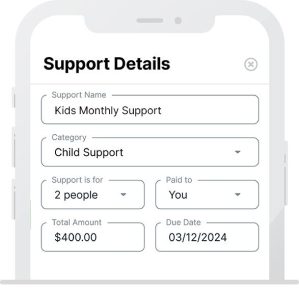At its core, the purpose of child support is to ensure the child’s basic needs are being met. Going further, the court is trying to reduce a child from experiencing drastically different standards of living between households. For example, it would be difficult for a child to live with dad half the time, who has a mansion and an abundance of resources, but then go live with mom the other half the time who is struggling to put food on the table. At minimum, the state tries to allocate both of the parents’ resources in a way that allows both parents to provide food, shelter, and clothing to the best of their abilities. This doesn’t mean each parent has to provide the exact same standard of living, but the child should have necessary resources at both homes.
Types of support
Understanding which expenses and payments need to be tracked or reported starts with first defining the types of child support a parent can receive. First, there is base guideline child support, calculated by a formula created by the state to determine monthly support owed. Second, there are child support “add-ons”, which in California, are separate expenses the parents are ordered to share (usually equally), such as childcare expenses, educational expenses, and uninsured medical costs.
Things can get tense
It isn’t hard to imagine that it becomes complicated, or even heated, for two exes to still be connected through their child. This tension can be heightened when money is involved. The paying parent, for example, might want to know what the other parent is doing with their child support check every month. Maybe this is out of pure curiosity, but maybe that curiosity is heightened when they see the receiving parent recently purchased a new car that they previously couldn’t afford. But can the paying parent demand to know what the other parent is spending their child support money on? When it comes to base child support, simply put, the answer is no.
Sharing resources
The state’s assumption is that the money is going toward basic and standard needs: housing, food, clothing. A parent paying child support should assume their payments are going to increase the overall ability for the other parent to support the child’s needs. It might seem “unfair” to the paying parent, but if they have significant resources and a certain standard of living, their child support payments may necessarily increase the standard of living for the receiving parent as well. Ultimately though, this benefits the child. Where courts may get involved is If the parent receiving child support isn’t sufficiently providing for the child’s basic needs. In this case, the issue is really one of custody, not of child support, which can impact who pays child support if there is a change to the custody order.
When to start tracking
However, it’s a whole different story when it comes to child support add-on expenses like medical costs and daycare expenses. These expenses must be tracked and accounted for because they are payments that should legally only be reimbursed upon proof that the other parent paid for the expense. Alternatively, the parents may agree to each pay their one-half share of expenses, such as daycare, directly to the provider. But even here, these are expenses that must be accounted for and proof requested/tracked. If either parent’s share of payments isn’t made per the order, parents can seek recourse in court.
SupportPay Can Help
When the possibility of court looms, it’s smart to use a technological solution, like SupportPay, to track requests and reimbursements for add-on expenses. In California, there are many requirements imposed on both parties to make sure payments are properly requested and paid. For example, the parent who incurred the expense (let’s say a $100 medical co-pay) must provide the other parent an itemized statement of the charges, with proof of payment, within 30 days of incurring the expense. The owing parent then has 30 days to reimburse $50, representing their one-half obligation. The owing parent should always keep in mind to reimburse the expense in such a manner that proof of payment is easily tracked, such as through SupportPay.









